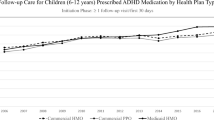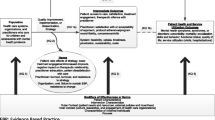Abstract
Purpose of Review
To provide an overview of the selection process and annual updates of the child mental health measures within the Child Core Set, describe national and statewide adherence rates, and summarize findings from a systematic literature review examining measure adherence rates and whether adherence is associated with improved clinical outcomes.
Recent Findings
Five national quality measures target child mental health care processes. On average, national adherence varied widely by state, and performance did not substantially improve during the past 5 years. Mean national adherence rates for the two measures related to timeliness of care were below 50%. For each measure, scientific evidence to support the association between adherence and improved clinical outcomes was scarce.
Summary
Investment in academic-agency partnered research to standardize methods for publicly reporting adherence to national child mental health quality measures and validation of these measures should be a national priority for child healthcare research.
Similar content being viewed by others
References
Papers of particular interest, published recently, have been highlighted as: • Of importance •• Of major importance
• Conway PH, Clancy C. Transformation of health care at the front line. JAMA. 2009;301(7):763–5 Landmark commentary supporting measurement-driven quality of care to transform the U.S. healthcare system.
Institute of Medicine, Committee on Quality of Health Care in America. Crossing the quality chasm: a new health system for the 21st century. Washington D.C.: The National Academies Press; 2001.
Institute of Medicine. Improving the quality of health care for mental and substance-use conditions. Washington D.C.: National Academy Press; 2006.
Zima BT, Murphy JM, Scholle SH, Hoagwood KE, Sachdeva RC, Mangione-Smith R, et al. National quality measures for child mental health care: background, progress, and next steps. Pediatrics. 2013;131(Supplement 1):S38–49.
•• Glied SA, Stein BD, TG MG, Beale RR, Duffy FF, Shugarman S, et al. Measuring performance in psychiatry: a call to action. Psych Services. 2015;66:872–8 Excellent summary of behavioral health measures endorsed by the National Quality Forum, assessment criteria, and rationale for need for more functional outcome measures.
American Academy of Pediatrics. Policy statement—the future of pediatrics: mental health competency for pediatric primary care. Available from: http://pediatrics.aappublications.org/content/pediatrics/124/1/410.full.pdf. Accessed 10 Oct 2018.
Webster-Stratton C, Taylor T. Nipping early risk factors in the bud: preventing substance abuse, delinquency, and violence in adolescence through interventions targeted at young children (0–8 years). Prev Sci. 2001;2(3):165–92.
•• Kilbourne AM, Beck K, Spaeth-Rublee B, Ramanuj P, O'Brien RW, Tomoyasu N, et al. Measuring and improving the quality of mental health care: a global perspective. World Psychiatry. 2018;17(1):30–8 Complete yet concise summary of the current state of measuring mental health quality, unique challenges to mental health care quality measurement, innovations, and recommendations for implementing quality measurement of mental health care.
Kilbourne AM, Keyser D, Pincus HA. Challenges and opportunities in measuring the quality of mental health care. Can J Psychiatry. 2010;55(9):549–57.
Pincus HA, Spaeth-Rublee B, Watkins KE. The case for measuring quality in mental health and substance abuse care. Health Aff. 2011;30(4):730–6.
Wilensky G. The need to simplify measuring quality in health care. JAMA. 2018;319(23):2369–70.
Houtrow AJ, Zima BT. Framing childhood mental disorders within the context of disability. Disability and health journal. 2017;10(4):461–6.
Children’s Health Insurance Program Reauthorization Act of 2009. Available from: https://www.congress.gov/bill/111th-congress/house-bill/2. Accessed 25 Sept 2018.
Medicaid.gov. Keeping America Healthy: July 2018 Medicaid & CHIP Enrollment Data Highlights. Available from: https://www.medicaid.gov/medicaid/program-information/medicaid-and-chip-enrollment-data/report-highlights/index.html. Accessed 25 Sept 2018.
Medicaid.gov. 2018 Core Set of Children's Health Care Quality Measures for Medicaid and CHIP. Available from: https://www.medicaid.gov/medicaid/quality-of-care/downloads/performance-measurement/2018-child-core-set.pdf. Accessed 25 Sept 2018.
H.R. 1892 One Hundred Fifteenth Congress of the United States of America. Available from: https://www.congress.gov/115/bills/hr1892/BILLS-115hr1892enr.pdf. Accessed 25 Sept 2018.
National Quality Forum. Strengthening the core set of healthcare quality measures for children enrolled in Medicaid, 2017. Available from: http://www.qualityforum.org/Publications/2017/08/Strengthening_the_Core_Set_of_Healthcare_Quality_Measures_for_Children_Enrolled_in_Medicaid,_2017.aspx. Accessed 25 Sept 2018.
National Quality Forum. Measure applications partnership: strengthening the core set of healthcare quality measures for children enrolled in Medicaid and CHIP, 2015. August 2015.
Medicaid.gov. 2017 Annual Reporting on the Quality Care for Children in Medicaid and CHIP (FFY 2016): Performance on the Child Core Set Measures for FFY 2016, 2015, 2014, 2013 (zip file). Available from: https://www.medicaid.gov/medicaid/quality-of-care/performance-measurement/child-core-set/index.html. Accessed 25 Sept 2018.
Zima BT, Bussing R, Tang L, Zhang L, Ettner S, Belin TR, et al. Quality of care for childhood attention-deficit/hyperactivity disorder in a managed care Medicaid program. J Am Acad Child Adolesc Psychiatry. 2010;49(12):1225–37. e11.
•• Blackburn J, Becker DJ, Morrisey MA, Kilgore ML, Sen B, Caldwell C, et al. An assessment of the CHIP/Medicaid quality measure for ADHD. Am J Manag Care. 2017;23(1):e1–9 Using a statewide Medicaid claims database, this study supports the primary reasons for failing the ADHD follow-up measure were lack of medication coverage and lack of follow-up visit within 30 days. Adherence to this measure was related to greater health service utilization and costs.
Zima BT, Norquist GS, Altchuler SI, Behrens J, Iles-Shih MD, Ng YKW, et al. Office visits to monitor stimulant medication safety and efficacy: recommended care. J Am Academy Child & Adolesc Psychiatry. 2018;57(6):438–9.
Centers for Medicare and Medicaid Services. Medicaid/CHIP Health Care Quality Measures: About the Technical Assistance and Analytic Support Program 2018. Available from: https://www.medicaid.gov/medicaid/quality-of-care/downloads/tafactsheet.pdf. Accessed 25 Sept 2018.
Centers for Medicare and Medicaid Services. Medicaid/CHIP Health Care Quality Measures. The State of Children’s Health Care Quality in Medicaid and CHIP: State Strategies to Promote Reporting and Performance. Available from: https://www.medicaid.gov/medicaid/quality-of-care/downloads/child-core-set-hps-strategies-brief.pdf. Accessed 25 Sept 2018.
Brinkman WB, Baum R, Kelleher KJ, Peugh J, Gardner W, Lichtenstein P, et al. Relationship between attention-deficit/hyperactivity disorder care and medication continuity. J Am Academy Child Adolesc Psychiatry. 2016;55(4):289–94.
Bussing R, Narwaney KJ, Winterstein AG, Newton DA, DeBar L, Boscarino JA, et al. Pharmacotherapy for incident attention-deficit/hyperactivity disorder: practice patterns and quality metrics. Curr Med Res Opin. 2014;30(8):1687–99.
Carroll AE, Bauer NS, Dugan TM, Anand V, Saha C, Downs SM. Use of a computerized decision aid for ADHD diagnosis: a randomized controlled trial. Pediatrics. 2013;132:e623–9.
•• Cummings JR, Ji X, Allen L, Lally C, Druss BG. Racial and ethnic differences in ADHD treatment quality among Medicaid-enrolled youth. Pediatrics. 2017;139(6):e20162444 Using a large, nine-state Medicaid claims data base, this study supports quality of care for Medicaid-enrolled youth initiating ADHD medication is poor, and racial/ethnic differences for the ADHD follow-up care measure are mixed.
Epstein JN, Kelleher KJ, Baum R, Brinkman WB, Peugh J, Gardner W, et al. Variability in ADHD care in community-based pediatrics. Pediatrics. 2014:peds-2014.
Geltman PL, Fried LE, Arsenault LN, Knowles AM, Link DA, Goldstein JN, et al. A planned care approach and patient registry to improve adherence to clinical guidelines for the diagnosis and management of attention-deficit/hyperactivity disorder. Acad Pediatr. 2015;15(3):289–96.
Fontanella CA, Hiance-Steelesmith DL, Bridge JA, Lester N, Sweeney HA, Hurst M, et al. Factors associated with timely follow-up care after psychiatric hospitalization for youths with mood disorders. Psychiatr Serv. 2015;67(3):324–31.
Williams CL, Cooper WO, Balmer LS, Dudley JA, Gideon PS, DeRanieri MM, et al. Evaluation and disposition of Medicaid-insured children and adolescents with suicide attempts. Acad Pediatr. 2015;15(1):36–40.
Heflinger CA, Shaw V, Higa-McMillan C, Lunn L, Brannan AM. Patterns of child mental health service delivery in a public system: rural children and the role of rural residence. J Behav Health Serv Res. 2015;42(3):292–309.
Anderson N MT. Improving health outcomes for children: summary of pediatric quality measures for children enrolled in MaineCare FFY 2009-FFY2012. Available from: https://www.maine.gov/dhhs/oms/pdfs_doc/ihoc/Summary_of_Pediatric_Quality_Measures_2012.pdf. Accessed 16 Oct 2018.
Becker ER, Constantine RJ, McPherson MA, Jones ME. Antipsychotic polypharmacy prescribing patterns and costs in the Florida adult and child Medicaid Populations. J Health Care Finance. 2013;40(1):40–67
Leckman-Westin E, Finnerty M, Scholle SH, Pritam R, Layman D, Kealey E, et al. Differences in Medicaid antipsychotic medication measures among children with SSI, foster care, and income-based aid. J Manag Care Spec Pharm. 2018;24(3):238–46.
Rettew DC, Greenblatt J, Kamon J, Neal D, Harder V, Wasserman R, et al. Antipsychotic medication prescribing in children enrolled in Medicaid. Pediatrics. 2015;135:658–65.
Saldaña SN, Keeshin BR, Wehry AM, Blom TJ, Sorter MT, DelBello MP, et al. Antipsychotic polypharmacy in children and adolescents at discharge from psychiatric hospitalization. Pharmacotherapy. 2014;34(8):836–44.
Sohn M, Burgess M, Bazzi M. Antipsychotic polypharmacy among children and young adults in office-based or hospital outpatient department settings. Pharmacy. 2017;5(4):64.
Thackeray J, Crane D, Fontanella C, Sorter M, Baum R, Applegate M. A Medicaid quality improvement collaborative on psychotropic medication prescribing for children. Psychiatr Serv. 2018;69(5):501–4.
Barclay RP, Penfold RB, Sullivan D, Boydston L, Wignall J, Hilt RJ. Decrease in statewide antipsychotic prescribing after implementation of child and adolescent psychiatry consultation services. Health Serv Res. 2017;52(2):561–78.
Finnerty M, Neese-Todd S, Pritam R, Leckman-Westin E, Bilder S, Byron SC, et al. Access to psychosocial services prior to starting antipsychotic treatment among Medicaid-insured youth. J Am Academy Child & Adolesc Psychiatry. 2016;55(1):69–76. e3.
Bhatta S, Champion JD, Young C, Loika E. Outcomes of depression screening among adolescents accessing school-based pediatric primary care clinic services. J Pediatr Nurs. 2018;38:8–14.
Fallucco EM, Seago RD, Cuffe SP, Kraemer DF, Wysocki T. Primary care provider training in screening, assessment, and treatment of adolescent depression. Acad Pediatr. 2015;15(3):326–32.
Lewandowski RE, O’Connor B, Bertagnolli A, Beck A, Tinoco A, Gardner WP, et al. Screening for and diagnosis of depression among adolescents in a large health maintenance organization. Psychiatr Serv. 2016;67(6):636–41.
Zenlea IS, Milliren CE, Mednick L, Rhodes ET. Depression screening in adolescents in the United States: a national study of ambulatory office-based practice. Acad Pediatr. 2014;14(2):186–91.
Marino L, Wissow LS, Davis M, Abrams MT, Dixon LB, Slade EP. Predictors of outpatient mental health clinic follow-up after hospitalization among Medicaid-enrolled young adults. Early Interv Psychiatry. 2016;10(6):468–75.
Toteja N, Gallego JA, Saito E, Gerhard T, Winterstein A, Olfson M, et al. Prevalence and correlates of antipsychotic polypharmacy in children and adolescents receiving antipsychotic treatment. Int J Neuropsychopharmacol. 2014;17(7):1095–105.
Corathers SD, Kichler J, Jones N-HY, Houchen A, Jolly M, Morwessel N, et al. Improving depression screening for adolescents with type 1 diabetes. Pediatrics. 2013;132:e1395–402.
Forman-Hoffman V, McClure E, McKeeman J, Wood CT, Middleton JC, Skinner AC, et al. Screening for major depressive disorder in children and adolescents: a systematic review for the US preventive services task force. Ann Intern Med. 2016;164(5):342–9.
Wissow LS, Brown J, Fothergill KE, Gadomski A, Hacker K, Salmon P, et al. Universal mental health screening in pediatric primary care: a systematic review. J Am Academy Child & Adolesc Psychiatry. 2013;52(11):1134–47. e23.
Centers for Medicare and Medicaid. Quality of care for children and adults in Medicaid and CHIP: overview of findings from the 2017 Child and Adult Core Sets. Available from: https://www.medicaid.gov/medicaid/quality-of-care/downloads/performance-measurement/ffy-2017-core-set-reporting.pdf. Accessed 25 Sept 2018.
Ranallo PA, Kilbourne AM, Whatley AS, Pincus HA. Behavioral health information technology: from chaos to clarity. Health Aff. 2016;35(6):1106–13.
Price M, Yuen EK, Goetter EM, Herbert JD, Forman EM, Acierno R, et al. mHealth: a mechanism to deliver more accessible, more effective mental health care. Clin Psychol Psychother. 2014;21(5):427–36.
Iyer SP, Spaeth-Rublee B, Pincus HA. Challenges in the operationalization of mental health quality measures: an assessment of alternatives. Psychiatr Serv. 2016;67:1057–9.
Author information
Authors and Affiliations
Corresponding author
Ethics declarations
Conflict of Interest
Bonnie T. Zima and Juliet B. Edgcomb declare no conflict of interest. Samantha A. Shugarman has received Cooperative Agreement Measure Development Funding from the Centers for Medicare and Medicaid Services.
Human and Animal Rights and Informed Consent
This article does not contain any studies with human or animal subjects performed by any of the authors.
Additional information
Publisher’s Note
Springer Nature remains neutral with regard to jurisdictional claims in published maps and institutional affiliations.
This article is part of the Topical Collection on Public Policy and Public Health
Rights and permissions
About this article
Cite this article
Zima, B.T., Edgcomb, J.B. & Shugarman, S.A. National Child Mental Health Quality Measures: Adherence Rates and Extent of Evidence for Clinical Validity. Curr Psychiatry Rep 21, 6 (2019). https://doi.org/10.1007/s11920-019-0986-3
Published:
DOI: https://doi.org/10.1007/s11920-019-0986-3




